Since its inception, the Elk River Landfill has had a great record in meeting and exceeding city, state and federal guidelines. Our commitment to the community’s environmental and social health means that we are continuously working to operate our facility in the safest way possible.
Design
The Elk River Landfill is designed to dispose of non-hazardous solid wastes. The current permits require all disposal areas to be constructed with a composite liner system and leachate collection system. The leachate collection system gathers wastewater that is generated by the overlying municipal solid waste.
The primary liner will consist of a synthetic 60-mil-thick high-density polyethylene (HDPE). The primary liner will be underlain by two feet of Clay. Together, these two components of the liner system prevent contaminants from penetrating the surrounding environment.
The leachate collection system will consist of synthetic drainage material called a geocomposite. The geocomposite is comprised of high-density polyethylene channels manufactured to rapidly convey liquids such as leachate. It is considered to be an acceptable equivalent to one-foot of granular drainage material. A non-woven filter geotextile is attached to prevent infiltration of soil that will clog the geocomposite. Base grades are sloped to a central collection sump which is designed for subsequent removal of leachate to an onsite storage tank.
All areas of the liner system will be protected by a 1.0 ft thick soil layer. The soil layer will prevent the overlying waste from penetrating and damaging the liner system.
Following completion of the various liner components, landfill construction is accomplished by the area method. Open refuse is minimized by the construction of daily work areas sized to handle only each day's volume, and subsequently covered and sealed with soil at the end of each day.
Groundwater Monitoring
 The current groundwater-monitoring program includes monitoring wells placed around the active areas of the Elk River Landfill. The locations of the wells are principally selected to intercept groundwater that flows beneath the landfills. The depth of the monitoring wells have been selected to monitor the groundwater. Monitoring wells are sampled and inspected on a regular basis in accordance with state and federal guidelines.
The current groundwater-monitoring program includes monitoring wells placed around the active areas of the Elk River Landfill. The locations of the wells are principally selected to intercept groundwater that flows beneath the landfills. The depth of the monitoring wells have been selected to monitor the groundwater. Monitoring wells are sampled and inspected on a regular basis in accordance with state and federal guidelines.
Landfill Linear Construction
All components of the liner system construction are supervised and inspected to ensure that the completed landfill will be protective of the environment. This includes manufacturing of the HDPE liner and installation of all components of the liner system during construction.
Preparation of the existing ground surface is performed prior to construction of the liner system to achieve the design subgrade configuration and remove rocks that could penetrate the liner. After preparation of the sub-base, a 2-ft thick clay layer is installed on the base of the landfill. The 60 mil HDPE liner will be installed over the clay liners. Finally, a drainage layer of 1 foot of sand will placed above the HDPE liner.
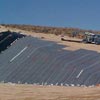
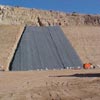
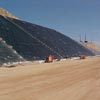
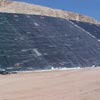
The HDPE liner is fabricated, installed, tested and repaired in accordance with approved guidelines. All manufacturer's recommendations and installation procedures are overseen by independent Quality Assurance personnel.
A brief summary of the construction guidelines is presented below:
- The liner installation contractor has been approved by the geomembrane manufacturer, and has the necessary personnel and equipment to perform the work.
- All personnel performing field liner seaming are qualified by experience or by passing field seaming tests.
- Field seams will be joined by extrusion or fusion welds, using only equipment and materials specifically approved. Prior to seaming, the entire seam area will be free of moisture, dirt, dust, foreign material, and debris of any kind.
Final acceptance of the geosynthetic liner system is based on certification by the Quality Assurance/Quality Control (QA/QC) consultant that the geosynthetic materials have been properly installed.
Following approval of a lined area by the QA/QC inspector, overlying protective cover layer materials are placed.
Landfill Gas Monitoring
A regular gas-monitoring program has been in effect at the Elk River Landfill and includes permanent probes located along the perimeter of the landfill. The probes are installed to monitor the entire depth of waste to ensure that methane gas does not migrate off the landfill property.
Landfill Gas Collection and Recovery
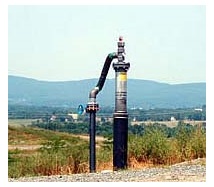 The Elk River Landfill gas collection and recovery system is designed to achieve the following:
The Elk River Landfill gas collection and recovery system is designed to achieve the following:
- Reduce the potential for off-site landfill gas migration
- Minimize landfill gas emissions from the surface of the landfill
- Control landfill odors
A landfill gas recovery system is in operation on the active portions of the Elk River Landfill. The purpose of the system is to collect the methane gas and use its fuel specially modified engine-generators to produce electricity. Elk River Municipal Utilities then distributes the electricity to its customers.
The gas recovery system is designed to provide continuous removal of landfill gas in active areas of the landfill and consists of gas extraction wells, gas collection piping, vacuum collection skid, and enclosed flare. Gas wells are installed at appropriate spacing to efficiently collect gas generated by the waste. The wells are connected to a pipe network that transmits gas to a high efficiency flare for destruction. A vacuum is applied to the gas well field by a blower system that is located adjacent to the flare.